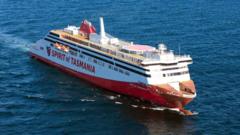In a significant turn of events, the newly constructed Spirit of Tasmania IV ferry is heading to be mothballed in Edinburgh, a direct consequence of what is being dubbed a "ferries fiasco" in Tasmania, Australia. The 212-meter vessel, constructed at a shipyard in Finland, must be relocated from its current dock to avoid potential damage from pack ice as winter approaches.
The ferry will be stored at the Port of Leith since it cannot be accommodated at existing berths in Devonport, Tasmania. A new facility to handle the size of this vessel is not expected to be ready until late 2026 or 2027. Initially hailed as a transformative asset for Tasmania's tourism industry, the ferry has instead become a focal point of political scandal, plagued by construction delays and rising costs.
Australian media have branded the situation a "debacle," while opposition leader Dean Winter condemned it as the "biggest infrastructure stuff-up" in the state's history. In response to the growing criticism, both Michael Ferguson, the infrastructure minister, and TT-Line chairman Mike Grainger resigned earlier this year.
Recent announcements confirm that the Devonport berth, originally scheduled for completion by August 2024, now faces at least a two-year delay. TT-Line chief executive Bernard Dwyer emphasized the necessity of moving the ferry to a more suitable location, explaining, “To ensure the vessel’s safety and preservation, we will temporarily relocate it to Leith, Scotland."
While there are discussions about potentially leasing out the vessel, significant work remains before that can take place due to contractual obligations necessitating final fittings to be completed in Australia. Furthermore, despite the need for new vessels in Scotland, the sheer size of the Spirit of Tasmania IV and its sister ship, which is still under construction, makes their utilization in that region improbable.
The situation in Tasmania has drawn comparisons to Scotland's own "ferries fiasco," where CMAL, a state-owned ferry operator, ordered vessels that ultimately proved too large for existing infrastructure. Delays in projects, such as the Ardrossan redevelopment, further complicate the landscape, echoing the issues faced across the globe with ferry infrastructure planning.




















